
Brief - An investigation into user need and requirements to help inform the design of a product that will regulate breathing in-order to calm and improve a user's wellbeing.



Initial brainstorming - The project commenced with an initial brainstorming session aimed at identifying innovative solutions to address the challenges of anxiety, considering the specific environment where the potential product would be utilised.

Initial storyboard - I created a storyboard illustrating the adverse impacts of anxiety and panic attacks, vividly portraying heightened breathing, headaches, and increased stress.

Mental health services and the pandemic problems - This article highlights the problems surrounding mental health support including lack of
funding and being overlooked. The article also highlights how the COVID-19 pandemic increased to prevalence of anxiety and depression globally.

Solution research - Further research was done looking into solutions to mitigate the negative effects of anxiety and panic attacks including: breath work, CBT therapy, aerobic exercise, maintaining blood sugar levels.

Finalised research statistics - To show problems, environment, users, markets and solutions.


Breathing regulation devices - For further research extensive analysis of existing breathing regulation products was taken looking at the pain-points and motivators of each of the products.

Melo analysis - The Melo meditation device was selected and an extensive product breakdown was taken of the device. Melo was selected to be analysed as the product aims to regulate the users breathing in order to mitigate the negative effects of anxiety and panic attacks.

Melo analysis - The packaging of the Melo meditation device was further analysed and I took part in a body storming session to fully analyse the
device.

Tiffbox product analysis - A product analysis of the Tiffbox was conducted, considering its immersive calming features, with a focus on its potential to effectively induce a sense of calmness in the user.


Wellness calming mood-board - To inspire the design of the device, a calming wellness mood board was meticulously crafted, capturing serene elements and aesthetic influences conducive to promoting a sense of tranquility.

Furnification moodboard - A moodboard featuring products with furnification features was created and analysed, offering insights and inspiration for incorporating functional and aesthetic elements into the design process.

Home pod product moodboard - A moodboard of home pod products was devised to inspire and guide the design process, providing a visual reference for the incorporation of relevant elements and features into the project.

Overall ideation process - The image above showcases a snapshot of the overall ideation undertaken in the project from initial rough post-it note sketches to the final form.

Final storyboard scenario of use - The storyboard intricately illustrates an immersive calming experience in the top left, breathing training on the top right, on-the-go breathing tracking and regulation in the bottom left, and regular wellbeing meetings with a wellbeing practitioner in the bottom right, offering a comprehensive visualisation of the product's diverse features.
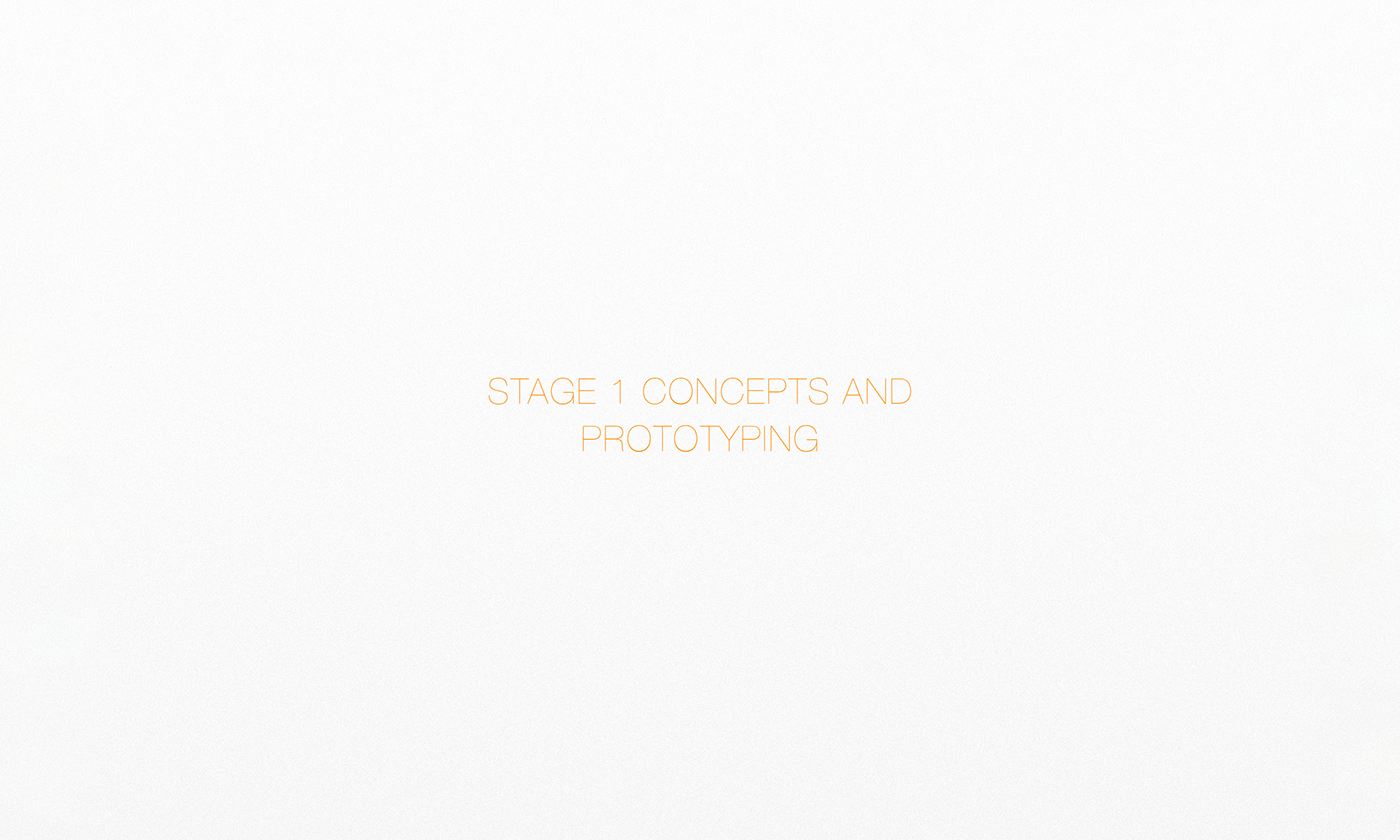
Stage 1 concepts - After conducting thorough initial research and product analysis, I designed three distinct concepts that embody innovative
solutions to mitigate the negative effects of anxiety and panic attacks.

Concept 1 - This concept aims to train the breath on a regular basis. It integrates VR and breathing sensors to track breathing and guide the user in a breathwork session. The product can be is used for calming breathwork sessions, the integrated VR element will allow for a fully immersive calming experience as it will completely take the user out of their current environment. The device again tracks breaths per minute and CO2 output of the user. As a result of the tracked data the UI on the VR will guide the user in a personalised breathwork session. There may also be the possibility to integrate aromatherapy into the device to enhance the calming experience.

Ideation process

CAD analysis

Low fidelity prototyping

Concept 1 rendering

Concept 2 - This concept aims to stabilise respiratory rate and normalise the user's exhaled CO2 level.The breathing device contains sensors that detect exhaled CO2 and will also calculate the user's breaths per minute. The device includes a heart rate variability sensor for the thumb. When the user reaches the desired heart rate the device will indicate that the user can stop the breathing process. As a result of the tracked data: heart rate variability, breaths per minute and CO2 output, the device can also connect to regular headphones via Bluetooth and will give personalised guided breathing feedback. The device also uses haptic feedback to guide the user with the breathing process. The device can be used in both an acute situation and daily for breathwork training.
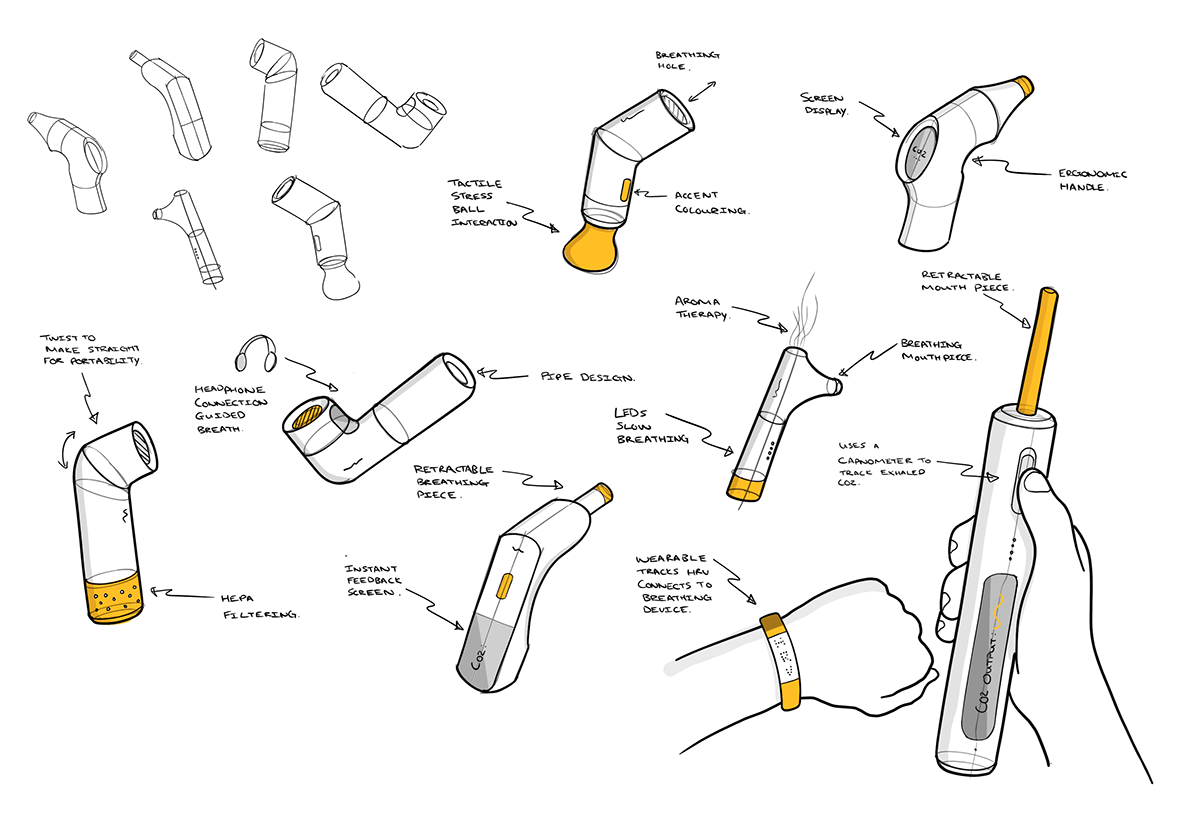
Ideation process
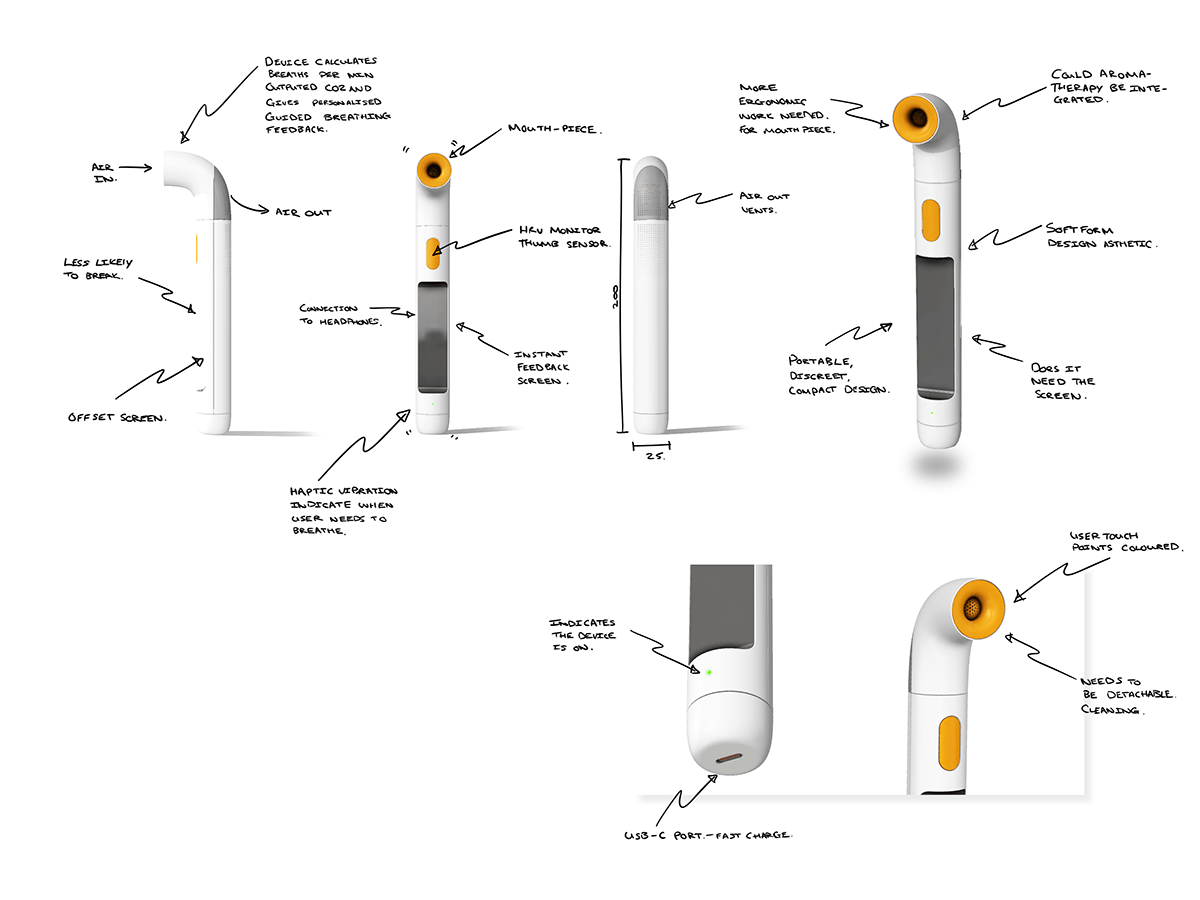
CAD analysis

Low-fidelity prototype

Concept 2 render

Concept 3 - The device will be used to track and record mood levels throughout the day. The wearable tracker does not include a screen so that the user is not constantly checking the device (causing further obsessive thoughts). The device will collect data on heart rate variability and skin conductance. When the device detects that the user is at a higher level of stress then the device will change colour from blue to red to indicate when the user must slow their breathing. When the breathing mode is activated, LEDs or symbols will show the user when they need to breathe in and out. The device also offers the option for the user to verbally record situations that made them stressed. When the user arrives home the device should be placed on the hub and the day's data is uploaded. A personal Al system will then collate the recorded data and refer the user to self-help information and techniques to mitigate the symptoms next time. The hub can also allow access to a specialist who will also receive the recorded data. The specialist is able to connect with the user on a regular basis as part of a subscription-based package. The device could also offer the option to connect with other users who may suffer with similar symptoms to allow users to exchange experiences. A problem shared is a problem halved!

Ideation process

CAD analysis

Low fidelity prototype
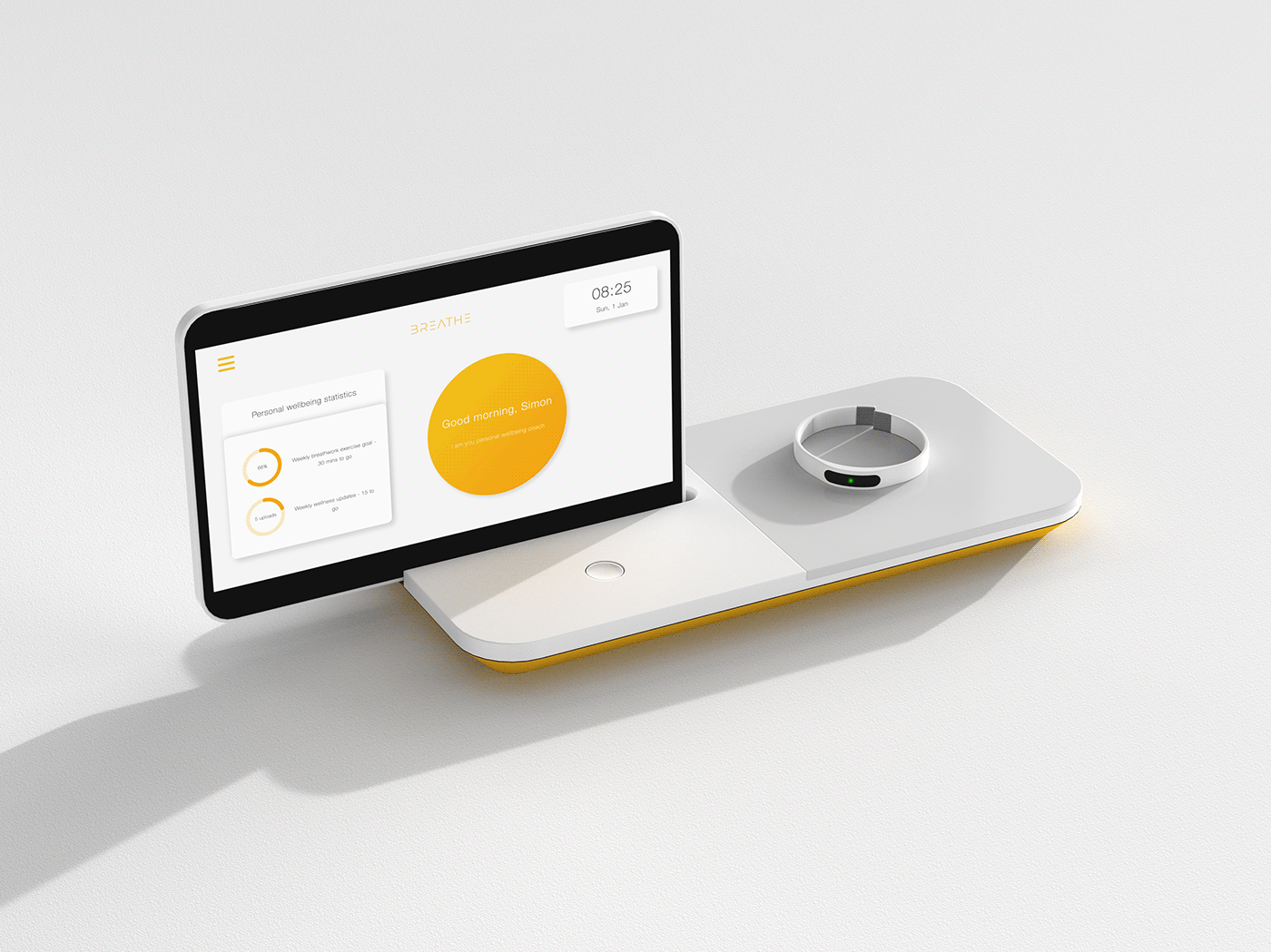
Concept 3 render

Concept selection - After showing the concepts to multiple users, I decided to select concept 1 due to a number of factors. Concept 1 was desirable due to its discreetness, portability, non invasiveness and ability to have long and short-term relief. However, a number of improvements need to be made to the ergonomics of the device and the immersive calming experience within the home. Notably, elements of concept 3, such as access to a specialist and a large immersive viewing screen were selected to carry forward to the end design.

Final stage 1 concept ideation - Further ideation was carried out to merge some of the features from concept 1 and concept 3 to create a new concept.

CAD prototype mock-up

Final stage 1 functional prototype - I constructed a functional prototype of the concept to demonstrate the the different features of the device to users. The concept includes a magnetic dock for the handheld device, a projector for immersive visuals, aroma diffusion module and a rotational selection dial.


Stage 1 functional prototype - The initial prototype was tested with a wide variety of users to gain a broad range of insights on its functions, size and
aesthetics (using stage 1 renders).

Final stage 1 concept render



Stage 1 concept changes - Numerous insights were gained as a result of initial user testing. These included making the hub and handheld device more compact to improve portability and discreetness both in the home and on the go, adding features (such as notifications) to more seamlessly integrate the breathing training into users' routine, a more intuitive way to change the aroma scent and a more user-friendly selection dial.

Stage 1 concept changes - Further changes were devised such as a carry cord and an interchangeable mouthpiece.

Stage 1 concept changes - I decided that an easier method of refilling the aroma was necessary and an indication light for the aroma diffusion would
improve the user experience.

Product disassemblies - In the exploration phase, disassemblies of potential technologies were conducted to discern the necessary components essential for the development of the breathing regulation device, ensuring a comprehensive understanding of the required technological elements. I conducted product disassemblies of a miniature projector unit and an aroma diffuser.

Projector analysis

Projector disassembly

Projector disassembly

Aroma diffuser disassembly

Physical dial/button development - In an effort to enhance the user experience and foster a stronger emotional connection to the device, I aspired to incorporate a physical dial control into the design, aiming to provide a tactile and interactive interface that resonates with users on a deeper level.

Dial button inspiration moodboard

CAD analysis

CAD analysis

CAD analysis

3D printed button prototypes



User testing - Multiple users tested the physical button dials. As a result of testing, users felt that the placement of the button dial was too close to the handheld device. Users also felt that reducing the clutter of the devices top surface was necessary.

Scent cartridge and cartridge holder development - In order to make the user experience more seamless, I realised that I had to design a more
intuitive method of taking the scent cartridges out.

Aroma scent pod V1

Aroma scent variations

Aroma cartridge variations - Numerous variations of the aroma cartridge were devised with a focus on reducing the size of the cartridge but also
reducing the number of parts.

Aroma cartridge mechanism ideation - After initial user testing, I found out that a more intuitive method of changing the aroma was needed. I
devised that a push to open mechanism should be used to eject the aroma cartridge.
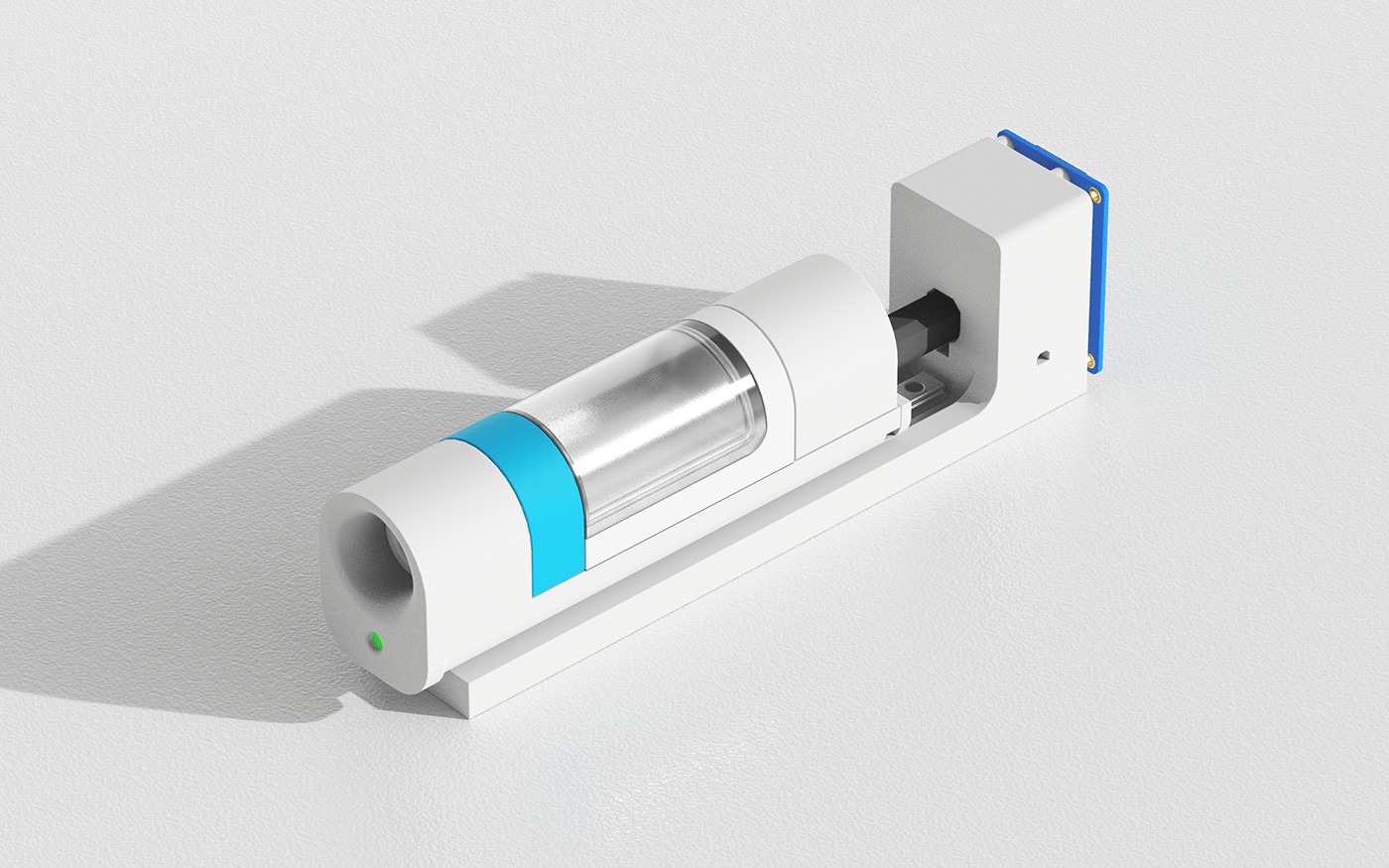
Aroma cartridge holder development - During the second stage of the project, a portion of my time was dedicated to the design of the aroma
cartridge ejection mechanism. This component featured a push-to-open mechanism coupled with a linear guide rail allowing for a seamless sliding
motion. To secure the cartridge in place, I devised a spring-loaded clamp mechanism. This attention to detail aimed to optimise user experience and
functionality within the broader context of the project.

How it works - To eject the cartridge holder, the module can be pushed in slightly, a push to open mechanism pops the module out and the whole module can then be slid out further to allow the cartridge to be taken out.



User testing - The cartridge holder was tested on multiple users to gain feedback on their pain-points of its operation.

Aroma cartridge holder operation

Changes to be made - After user testing I devised multiple changes that needed to be made to the original design including: a smaller more compact design, a smaller diffusion hole, a pub cover and adding magnets to hold the cartridge in place when fully pulled out.

CAD progression

Aroma cartridge holder versions - After a number of iterations and testing, a final mechanism was devised. The mechanism is more compact in size, has a smaller diffusion hole for safety purposes and the cartridge has been resigned for easier insertion.

Miniaturised handheld Capnometer - The miniaturised haptic feedback Capnometer tracks and regulates the user’s breath, serving both in-home breath-work training and on-the-go anxiety situations. The handheld device, measures breaths per minute and irregular patterns, comparing them to the user’s baseline. Personalised haptic feedback cues, in the form of vibrations, guide the user in returning their breath to baseline.

Miniaturised Capnometer development - Through this stage of the project I researched into the type of sensor that would be used in the device to track irregular breathing patterns and hyperventilation. The capnometer serves as a highly accurate method for detecting irregular breathing patterns, allowing it to effectively identify signs of hyperventilation and potentially indicate the onset of a panic attack, providing valuable insights for timely intervention and support.

How it works - The miniaturised capnometer sensor employs an infrared emitter and receiver to detect irregular breathing patterns, utilising their capabilities to precisely monitor and analyse exhaled carbon dioxide levels for comprehensive respiratory assessment.

Mouthpiece development
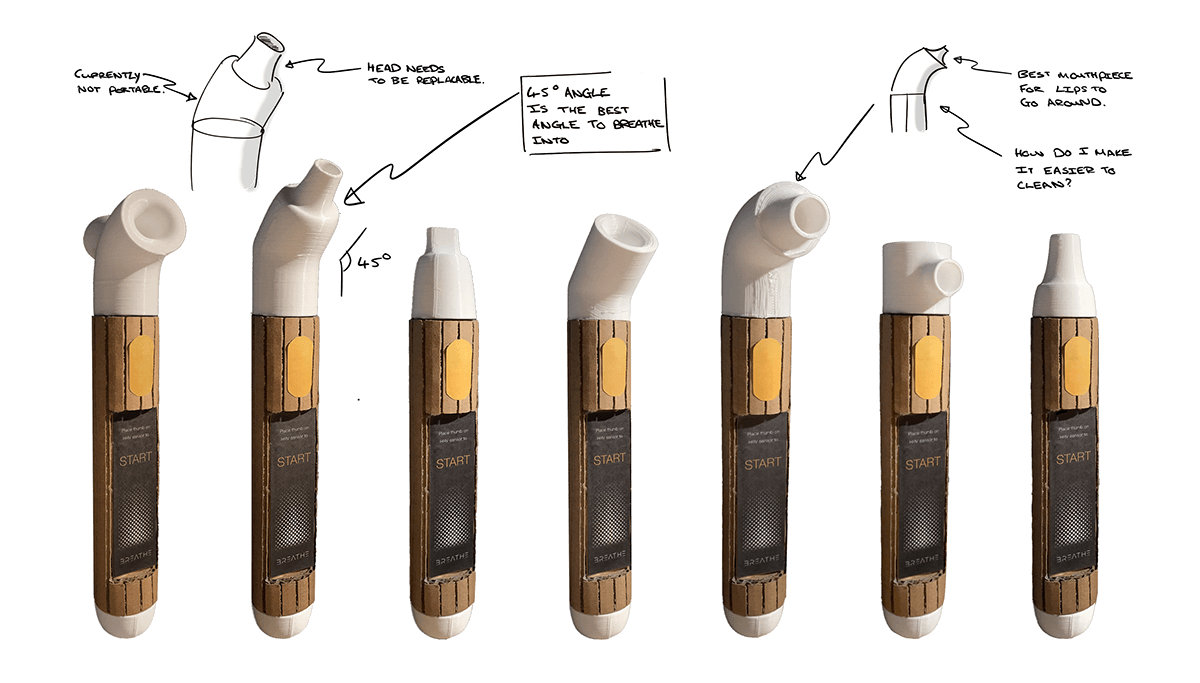
Handheld V1 - After recapping the ergonomic considerations made in Stage 1 I decided to make the handheld device smaller and more compact, for portability and discreetness.

Redesigned handheld V2 - I designed a smaller version of the handheld device with a rotating mouthpiece for increased portability.
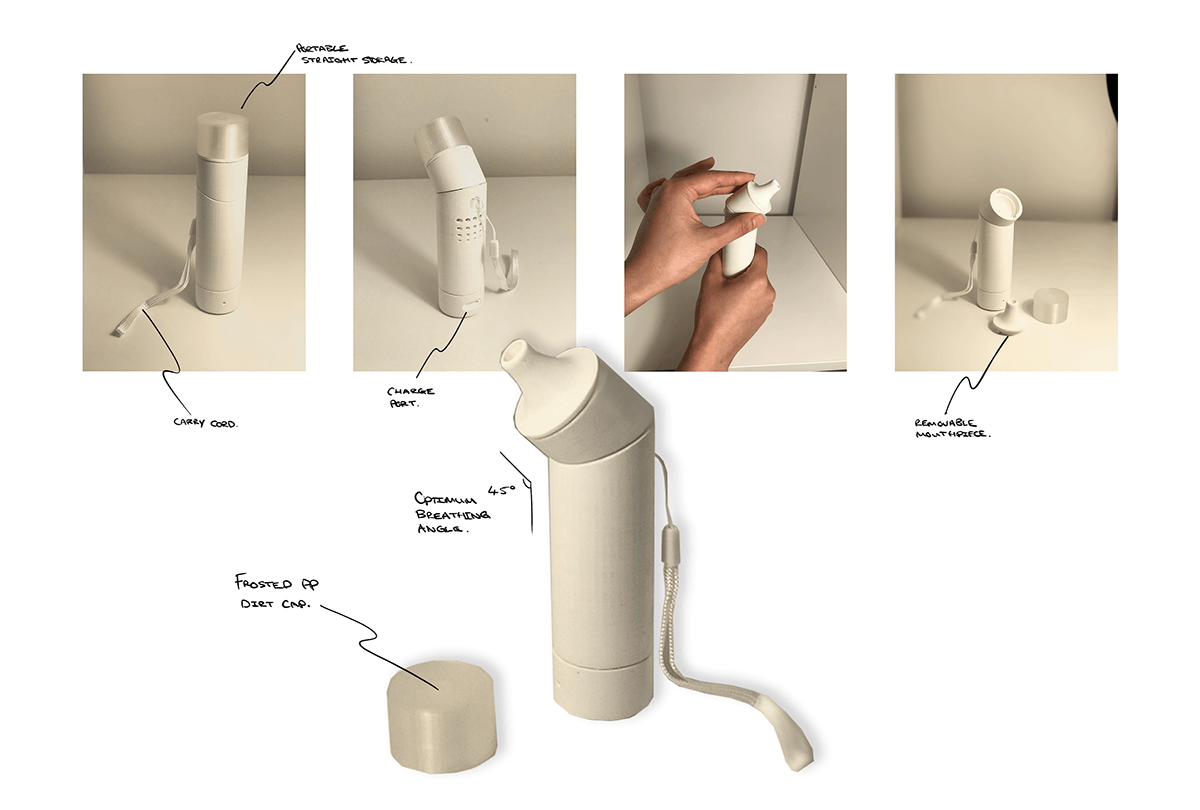
3D printed handheld prototype



Handheld device body-storming - Body-storming was used to test the V2 handheld prototype. The user raised the argument that when charging the device via usb-c, the device may topple over and it may be more advisable to lay the device down. The user also exclaimed that the carry cord was in the wrong position due to the rotational mouthpiece part. The user was still concerned about the overall size and discreetness of the device.

Inspiration moodboard for handheld V3

Redesign handheld V3 - I redesigned the handheld device to be even smaller in size adjusting the position of the usb-c port to the base of the device and including a flat base so the device can be sat flat on a surface.

How it works - The handheld Capnometer sensor gauges breaths per minute and irregular breathing patterns, subsequently comparing them to the
user's baseline; the device then employs personalised haptic feedback cues, in the form of vibrations, guiding the user to gradually regulate their
breath back to baseline.

Handheld prototype - A 3D-printed prototype was meticulously crafted to demonstrate the haptic vibrations integrated into the device, providing a
tangible representation of its feedback mechanism.

Switch variations


Inspiration moodboard

Meditation bowl inspiration moodboard - The shape and tactile design of the main hub was initially inspired by the rounded shape of a singing bowl to give a distinctive silhouette and symbolise an existing calming device.

Further ideation devised from the shape of a singing bowl


Aesthetic variation 1 - Boxy design aesthetic (scan QR code for AR experience)


Aesthetic variation 2 - Textured control dial (scan QR code for AR experience)


Aesthetic variation 3 - Curved design (scan QR code for AR experience)


Aesthetic variation 4 - Centralised design right hand control dial (scan QR code for AR experience)



Augmented reality testing - AR testing was employed to assess various aesthetics of the device, enabling users to provide feedback and preferences through interactive virtual experiences.

Concept selection and changes - Concept 4 was selected as the most desired aesthetic however further changes still needed to be implemented.

CAD analysis of internal components

CAD prototype mock-up

Final functional and CMF prototype



Final concept user testing

Stage one concept vs stage 2 final concept

Handheld exploded view - The handheld device includes a LI-battery, a miniaturised capnometer sensor, a USB-C connector and a miniature vibration motor.

Main hub exploded view - The main hub of the unit is made up of various modules and components. Some of these include the projector module, the aroma cartridge holder module, the internal ABS injection moulded shell (that the majority of components are attached to) and the outer polyester mix fabric.

Aroma cartridge holder module exploded view
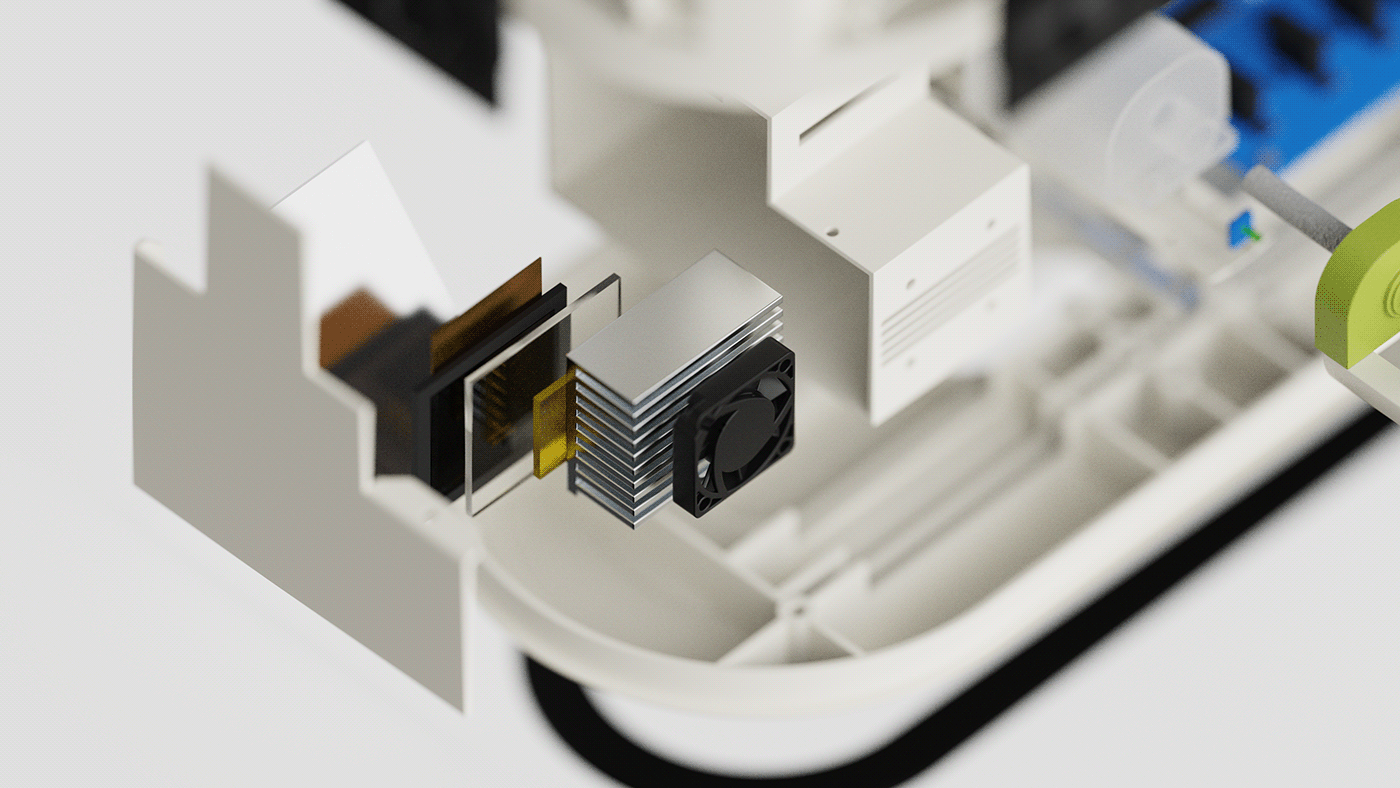
Projector internals exploded view

Camera PCB exploded view

What it does - Breathe tracks and regulates breathing to improve a user’s wellbeing, providing an immersive calming experience that focuses on stimulating the parasympathetic nervous system.
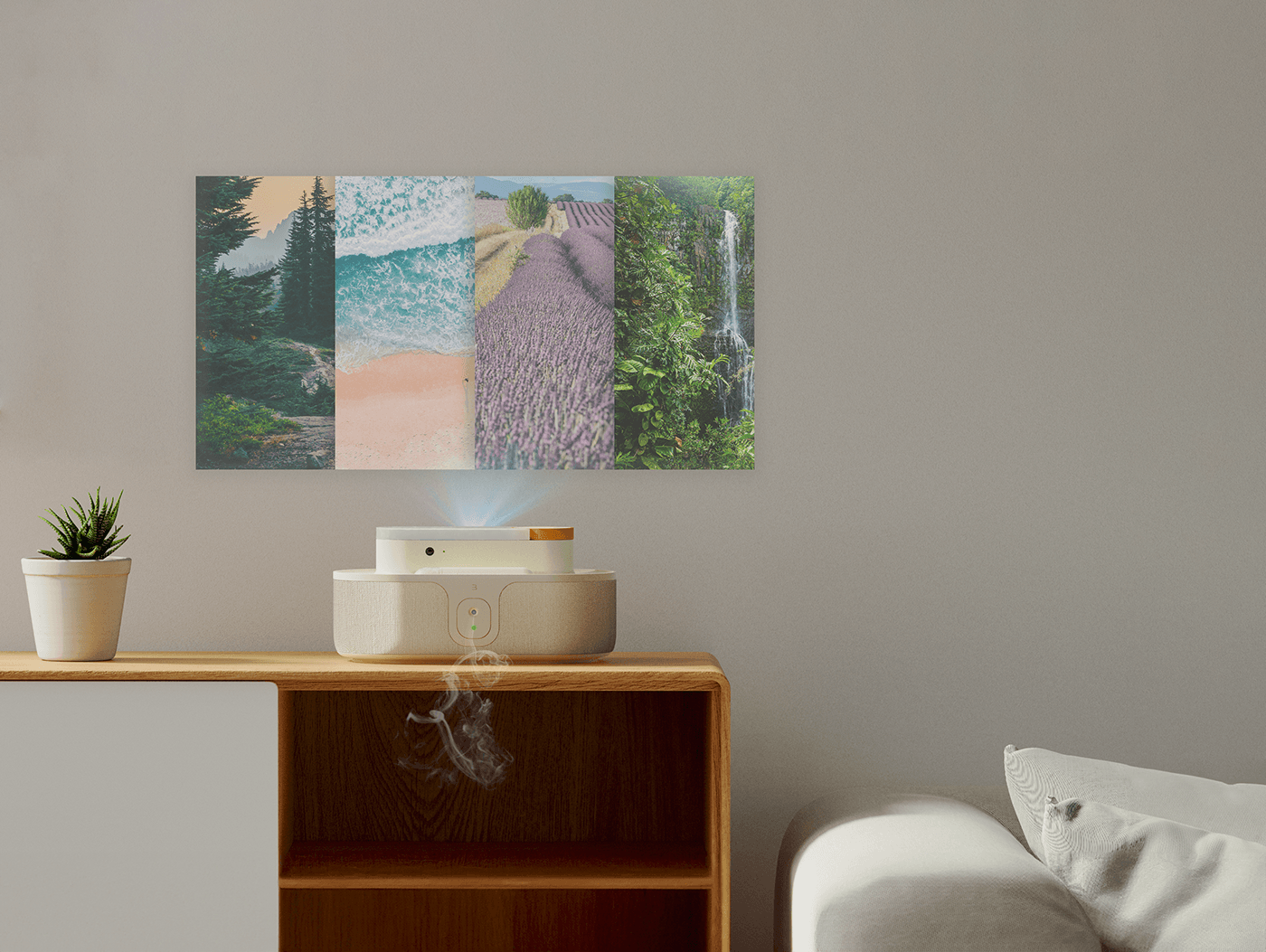
Immersive calming experience - The hub includes an ultra-short throw projector and a smart aroma diffuser to create an in-the-home immersive calming experience for the user through scent visuals and calming sounds.

Handheld breathing tracker - The product includes a miniaturised haptic feedback capnometer for tracking and regulating the users breath. The handheld device is used for in-the-home breath-work training and for acute anxiety situations on-the-go. The device measures breaths per minute and irregular patterns, comparing them to the user’s baseline. Personalised haptic feedback cues, in the form of vibrations, guide the user in returning their breath to baseline.

Specialist wellbeing practitioner - The 180-degree camera at the front of the device allows the user to connect with a wellbeing practitioner though
existing private mental health services such as Babylon and Better help for longer-term wellbeing improvement.

Handheld charging - The hub of the unit also includes a 3-pin magnetic charge dock for the handheld device.

Ultra-short throw projector - The hub incorporates an ultra-short throw projector, allowing the device to project images or content very close to the wall behind it, optimising space and enhancing the user's interactive experience.


X-ray rendering

Summary - Breathe revolutionises the way we approach our breath and well-being. With its advanced technology and user-friendly design, it empowers individuals to regulate and optimise their breathing patterns for enhanced relaxation and overall wellness. By prioritising simplicity and effectiveness, this device paves the way for a healthier and more mindful lifestyle.


Loughborough degree show 2023





